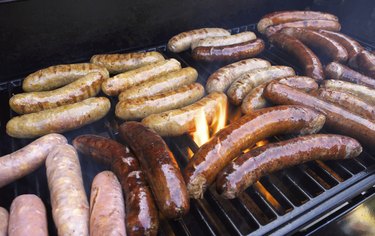
All living organisms are composed of proteins, which are chains of specific groups of amino acids linked together by chemical bonds. Protein synthesis begins in the cells where proteins carry out all the biological processes that sustain life. Amino acids, also called the building blocks of protein, fall into three categories: essential amino acids, which the body cannot make, and nonessential and conditional amino acids, which the body can synthesize. According to the University of Arizona, protein production is so vital to survival, if a sufficient amount of just one essential amino acid is not obtained from food, the body takes that amino acid from muscle tissue and other sources of protein within the body.
Protein Production
Video of the Day
Blood contains a constant supply of amino acid chemicals to fulfill the body's continuous need for protein. Instructions for making protein molecules are encoded in the DNA of genes. Explained simply, protein production occurs in a cell when DNA molecules transfer the genetic code for assembling amino acids to other molecules – RNA and ribosomes. After reading the information, construction begins with specific amino acids arranged in proper sequence to build each protein molecule according to the function it will serve.
Video of the Day
Essential Amino Acids
The nine essential amino acids include histidine, isoleucine, leucine, lysine, methionine, phenylalanine, threonine, tryptophan and valine. Phenylalanine produces tyrosine, a nonessential amino acid. The body cannot produce essential amino acids; they are obtained from the metabolic byproducts of protein digestion. The best dietary sources for amino acids are animal-based proteins, such as meat, eggs or dairy products, because they each contain all the essential amino acids. Amino acids are also found in plant-based foods, including vegetables, beans, grains, nuts and seeds. However, plant sources must be combined because they do not contain all the essential amino acids. An example is rice and beans, which form a complete protein when combined.
Nonessential Amino Acids
In addition to amino acids derived from protein metabolism, chemicals found in the body are used to produce nonessential amino acids. Nonessential amino acids include alanine, asparagine, aspartic acid and glutamic acid.
Conditional Amino Acids
The body also produces conditional nonessential amino acids. The amino acids in this group are only needed when the body becomes ill or stressed, according to Drexel University College of Medicine. Conditional amino acids include arginine, cysteine, glutamine, tyrosine, glycine, ornithine, proline and serine.
Functions of Protein
Proteins play a major role in almost all cellular functions. Antibody proteins provide immune protection. The proteins actin and myosin assist the movement and contraction of muscles, including the cardiac muscle, according to the Imperial College London, National Heart and Lung Institute. Protein carriers help transport molecules, such as hemoglobin in the blood, which supplies oxygen to tissues throughout the body. Protein also plays a role in bone growth and repairing tissues, such as muscle. Ligaments, organs, glands, nails and hair are made from proteins. Enzymes are protein molecules that serve as a catalyst in digestion and vital functions. Some hormones are proteins, such as insulin, which regulates blood sugar. Cells in the pituitary gland produce a protein hormone, which controls growth and metabolism.
- University of Arizona: The Chemistry of Amino Acids
- Drexel University College of Medicine: Amino Acids
- Imperial College London, National Heart and Lung Institute: A Brief Introduction to Muscle
- Genetics Home Reference, U.S. National Library of Medicine: How Do Genes Direct the Production of Proteins?
- Immune System Management: General Introduction to Amino Acids
- MedlinePlus: Amino Acids
- Genetics Home Reference, U.S. National Library of Medicine: Major Parts of a Cell